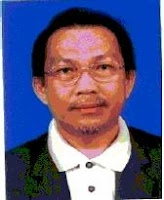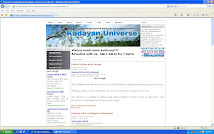 By Tuan Haji Ramlee Dua
By Tuan Haji Ramlee Dua The blog administrator wish to extend his sincere gratitude to the author of this article,
Tuan Haji Ramlee Dua, for giving the permission to publish
“HOW KADAYANS GOT THEIR NAME” in this blog. Tuan Haji Ramli Dua is a regular visitor and he had posted several interesting comments on the articles I've posted in this blog. Readers comments on this article are most welcome. Thank you.-
A.S. Kasah, AdministratorHOW KADAYANS GOT THEIR NAME
It is generally accepted that Kadayans were not native to the parts of Borneo they now inhabit, namely Brunei, Miri, Limbang, Lawas, Labuan, Sipitang and parts of Beaufort and Papar.
The general belief is that these people were brought to the Sultanate of Brunei to farm and produce food for the river-bound fishermen who were the forefathers of the present day Brunei Malays. It is further believed that these people originated from a certain part of what is todays' Indonesia.
It is of no doubt, however, that these people are of Malay stock and their dialect is very close to lingua franca Malay. Of all the dialects spoken in the archipelago and in Borneo in particular, only Kadayan and Brunei Malay (other than Sarawak Malay) display the closest semblance to Riau archipelago Malay (regarded by many linguistic experts as the benchmark of the Malay language).
No one has actually done a research into the real origins of the Kadayans. Their past is shrouded in mystery and the truth lost over time.
It is, however, possible to pinpoint to some approximate timeframe as to when these people were brought into Brunei proper.
This can be done by sieving through history and determining when the Sultanate of Brunei exerted influence over a much larger territory that could have exteded far into what is now Kalimantan and probably beyond. Accurate records of the history of the Sultanate, however, are scarce.
How, in what manner and in what number these people were intoduced into Brunei is very much open to question.
Firstly, there was no doubt that they ended up as farmers. They were also thought to be warriors who fought for the Sultans.
Secondly, did they come willingly or were they part of a slave trade? Or were they part of a wedding dowry for Brunei and other royalties in the region, the Sultante of Kutai in particular?
Thirdly, their numbers could not have been very large in the beginning because ships of those times were not capable of accomodating large numbers of passegers unless they arrrived in many shipments.
Fourthly, were they a cohesive group originating from a particular area in what is now Indonesia and speaking a distinct dialect of Malay?
Finally, did they come with their families?
To answer the last question, it would seem logical that they emigrated (willingly or otherwise) with their families. This was going to be a one-way trip. What promises or coercions were made by those responsible were not known.
What must be generally accepted would be the fact that the Sultante of Brunei (or Po-Ni as the Chinese knew it, an corrupted into "Borneo" by the early Europeans) was known as a regional power of the time and a potential source of maritime trade by others outside the region.
The spice trade lured Europeans, Arabs, Chinese and traders from the Indian sub-continent to the Malay Archipelago, much like gold lured thousands into America and Australia in later centuries. The movements of groups of people within the region must have been common and not peculiar to just Kadayans.
By the late 15th century, Malacca had become an important trading hub for the Archipelago. Its importance became its downfall for an important Malay Sultanate of the region, for in 1511, the Portuguese led by Alfonso D'Alberquerque, sailed with his fleet from Goa and captured Malacca. Sultan Mahmud fled to Johor to establish the Johor Sultanate and later his descendents established the Riau-Lingga Sultante.
By the time the Portuguese captured Malacca, the Sultanate had long adopted Islam and the religion was spreading quickly throughout the Archipelago.
Initially, the religion was said to have been brought by Arab traders into what is now Aceh and these traders ventured further into the Archipelago as far as what is now the Philippines. However, it must be stressed that merchant seamen of those days were not confined to Arabs, for there were no shortage of willing and able-bodied men who went on to be hired hands for these traders and they themselves adopted the religion and assisted proactively in its spread.
In 1521, when Ferdinand Magellen's fleet reached the Philippine Isalnds from across the Pacific Ocean, the people he met were already Muslims. This drove Magellan into a frenzy of forcing the local population of Mactan into accepting Christianity which led to his death at the hands of Lapu-Lapu.
During the same year, the remainder of the fleet sailed into Brunei (using Muslim sailor/guides from Mactan) and Antonio Pigafetta, an Italian adventurer and chronicler who somehow managed to obtain a berth on the voyage and survived the journey wrote glowing accounts of the Sultan's riches and "a large village built above water".
Whether Kadayans had already settled in Brunei at the time of the Portuguese's visit cannot be accurately stated. But for an important Sultanate of the region at the time, Brunei must have had something to offer to traders from other parts of the region and beyond. Not least was their ability to replenish ships' supplies with fresh food.
The Brunei Malay population who generally built their houses above water within the Brunei River were fishermen and not farmers. To survive, they had to be supplied with grains, vegetables and fruits by people living on dry land.
There were no doubt that several native tribes living around the area but whether they were practising permanent agriculture or merely hunter/gatherers was much open to question. Furthermore, common prcatises of head-hunting and constant tribal feuds would have made permanent settlements difficult. New migrants who were willing to till the land and strong enough to resist attacks were needed.
This was where Kadayans were brought in to perform this important task of providong much needed food for the population living on water and to feed constant arrivals of traders. The choice of why this particular group of people were chosen will never be accurately known. They could have been recommended by merchant seamen from what is todays' Indonesia to the Sultan as willing immigrants for instance.
But what can be accurately surmised would be the fact that when these people first arrived, they settled or were given land to till not far from the large population centre in the Brunei River.
What happened next was what caused them to be called Kadayans.
After the new immigrants opened up land and planted crops such as rice, fruits and vegetables, they resorted to bartering with the Brunei Malay fishermen for fish and other seafood in exchange for their produce along a river bank which later came to be called Sungai Kadayan (which is still known today by that name). This form of trade continued and became very popular.
One day, the Sultan, upon hearing of this trading activity along the river bank decided to see for himself and upon reaching the site, said to his minders, "BA KADAI-KADAIAN BISIDIA ANI..!" (meaning, "these people are making shops.."" Kadai (in Malay,Kedai) at that time was confined to shops within attap buildings owned by Arab, Chinese or other traders. Thee people were trading in the open, so they were "pretending" to have shops.
Over time, these traders or hawkers as we know them today, came to be known as "Orang Ba Kadai-Kadaian". The river bank where they traded came to be known as "Sungai Orang Ba Kadai'kadaian (the river where traders trade). Eventually these people came to be known as Kadai-kadaian and finally Kadayan.
In my next article I shall write about the Kadayan diaspora beyond Brunei into the north-western and south-western Borneo
......by Tuan Haji Ramlee Dua













































